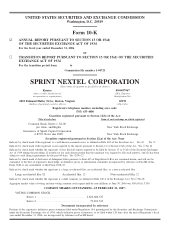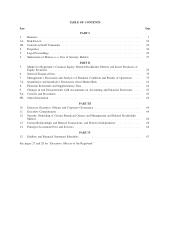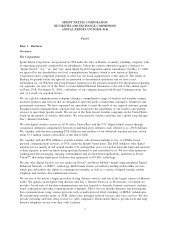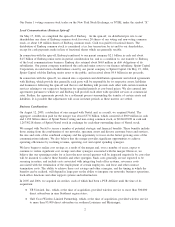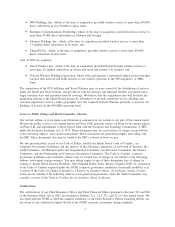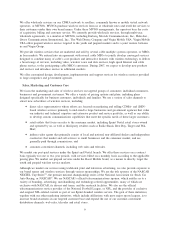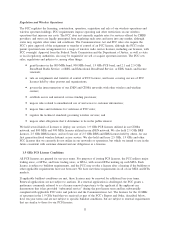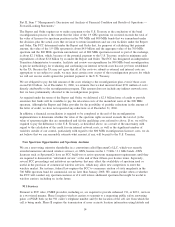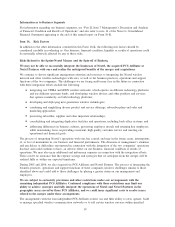Sprint - Nextel 2006 Annual Report Download - page 11
Download and view the complete annual report
Please find page 11 of the 2006 Sprint - Nextel annual report below. You can navigate through the pages in the report by either clicking on the pages listed below, or by using the keyword search tool below to find specific information within the annual report.Competition
We believe that the market for wireless services has been and will continue to be characterized by intense
competition on the basis of price, the types of services offered and quality of service. We compete with a
number of wireless carriers, including three other national wireless companies: AT&T (formerly known as
Cingular Wireless), Verizon Wireless and T-Mobile. AT&T and Verizon also offer competitively-priced
wireless services packaged with local and long distance voice and high-speed Internet services. We also
compete with regional providers of mobile wireless services, such as Alltel Corporation. Our Boost Mobile-
branded prepaid service competes with a number of regional carriers, including Metro PCS Communications,
Inc. and Leap Wireless International, Inc., which offer competitively-priced calling plans that include unlimited
local calling. Competition will increase to the extent that new firms enter the market as additional radio
spectrum is made available for commercial wireless services. We also expect competition to increase as a
result of other technologies and services that are developed and introduced in the future, including potentially
those using unlicensed spectrum, including wireless fidelity, or WiFi. The continued addition of MVNOs also
contributes to increased competition.
Pricing competition has led to declining average voice revenue per subscriber as we and our competitors have
offered more competitive service pricing plans, including lower priced plans, plans that allow users to add
additional units to their plans at attractive rates, plans with a higher number of bundled minutes included in
the fixed monthly charge for the plan, plans that offer the ability to share minutes among a group of related
customers, or a combination of these features.
In addition to pricing, we believe that our targeted customers are also likely to base their purchase decisions
on quality of service and the availability of differentiated features and services that make it easier for them to
get things done quickly and efficiently. We believe we compete based on our differentiated service offerings
and products, including our Power Vision applications and push-to-talk walkie-talkie feature. Several of our
competitors offer high-speed data, imaging, entertainment and location-based services and walkie-talkie-type
features that are designed to compete with our differentiated products and services. Other competitors have
announced plans to introduce similar services. If our competitors are able to provide applications and features
that are comparable to ours, any competitive advantage from the differentiation of our services from those of
our competitors would be reduced. To the extent that the competitive environment requires us to decrease
prices or increase service and product offerings, our revenue could decline or our costs could increase.
Competition in pricing and service and product offerings also may adversely impact customer retention. See
“Item 1A. — Risk Factors — We face intense competition that may reduce our market share and harm our
financial performance.”
Long Distance
Through our Long Distance segment, we provide a broad suite of wireline voice and data communications
services targeted to domestic business customers, multinational corporations and other communications
companies. We are one of the nation’s largest providers of long distance services and operate all-digital long
distance and Tier 1 IP networks.
Strategy
In an effort to maintain market share in an environment where many long distance communications services,
primarily stand-alone voice services, are being marketed and sold as low-cost commodities, our Long Distance
segment focuses on expanding its presence in the data communications markets by utilizing our principal
strategic assets: our high-capacity national fiber-optic network, our Tier 1 IP network, our base of business
customers, our established national brand and offerings available from our Wireless segment. We continue to
assess the portfolio of services provided by our Long Distance segment and are focusing our efforts on IP-
based services and de-emphasizing stand-alone voice services and non-IP-based data services. For example, in
addition to increased emphasis on selling IP services, we are converting many of our existing customers from
ATM and frame relay to more advanced IP technologies, in part to support our effort to move to one platform,
which will reduce our network cost structure. We also are taking advantage of the growth in voice services
9

